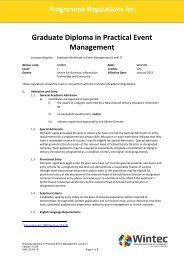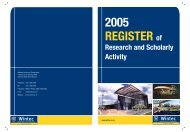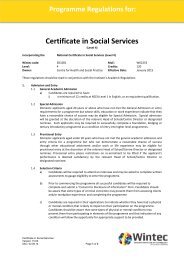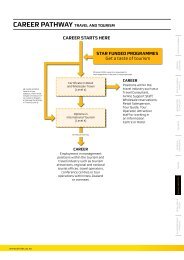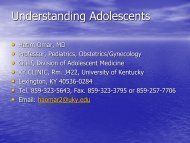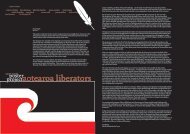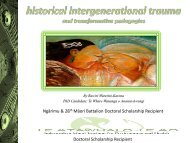2012 wintec annual report
2012 wintec annual report
2012 wintec annual report
You also want an ePaper? Increase the reach of your titles
YUMPU automatically turns print PDFs into web optimized ePapers that Google loves.
WINTEC ANNUAL<br />
REPORT <strong>2012</strong><br />
85<br />
Indicator(s)<br />
Percentage of SAC funded TEC<br />
students in employment or further<br />
study 6 months after completion<br />
Percentage of region’s school<br />
leavers from preceding year<br />
attending Wintec in preceding or<br />
current year<br />
Percentage of region’s outlying<br />
school leavers from previous year<br />
attending Wintec in preceding or<br />
current year<br />
Delivery of provision targeted to<br />
meet Youth Guarantee priorities<br />
Delivery of provision<br />
targeting refugee, migrant,<br />
and English as an Additional<br />
Language communities<br />
Delivery of community education<br />
targeting foundation, literacy and<br />
numeracy development<br />
Audited<br />
2011<br />
Outcome<br />
Target <strong>2012</strong><br />
Outcome<br />
Comment<br />
92% ≥90% 88% Outcomes for this indicator have been declining<br />
since 2008 with 2011 being an exception to this<br />
trend. The employment market continues to be<br />
challenging for graduates but we are pleased<br />
that our retention rate increased again in <strong>2012</strong><br />
to 70% (target is ≥ 54%).<br />
19% ≥16% 17% The Ministry of Education has altered its<br />
calculation method for school leavers and<br />
has advised that outcomes using new and<br />
old methodologies are not comparable.<br />
However applying the new methodology<br />
retrospectively to 2011 provides a result<br />
of 17%, indicating 2011 performance<br />
has been maintained in <strong>2012</strong>.<br />
13% ≥12% 10% The new method of calculating a school leaver<br />
means the 2011 and <strong>2012</strong> outcomes cannot be<br />
directly compared. Target was set under the<br />
old methodology. Retrospectively applying the<br />
new methodology to 2011 gives a result of 11%<br />
indicating a slight decline in enrolments from<br />
the wider region.<br />
195 places<br />
delivered under<br />
Youth Guarantee<br />
and WTA by<br />
December <strong>2012</strong><br />
260 places<br />
delivered<br />
through<br />
Foundation<br />
for Focussed<br />
Training<br />
Opportunities,<br />
Refugee Study<br />
Grant and<br />
Intensive Literacy<br />
and Numeracy<br />
provision<br />
107 EFTS<br />
delivered under<br />
ACE by December<br />
<strong>2012</strong><br />
237<br />
places<br />
delivered<br />
317<br />
places<br />
delivered<br />
A good result as part of our strategic priority of<br />
improving outcomes for youth.<br />
This strong result contributes positively to the<br />
development of foundation language, literacy<br />
and numeracy skills within our communities.<br />
104 EFTS Adult and Community Education (ACE) EFTs have<br />
been used to deliver foundation and literacy<br />
and numeracy skills to a range of community<br />
groups within Hamilton and the wider region<br />
including our local Pasifika community,<br />
Otorohanga, Te Kuiti, Waihi and Thames.<br />
STATEMENT OF SERVICE PERFORMANCE<br />
1<br />
2<br />
3<br />
4<br />
5<br />
6<br />
7<br />
8<br />
9<br />
10



